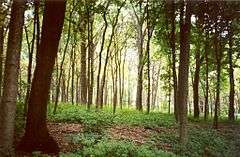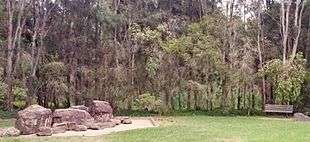Woodland
A woodland (/ˈwʊdlənd/ (![]()
Extensive efforts by conservationist groups have been made to preserve woodlands from urbanization and agriculture. For example, the woodlands of Northwest Indiana have been preserved as part of the Indiana Dunes.[3][4][5]
Definitions
United Kingdom
Woodland is used in British woodland management to mean tree-covered areas which arose naturally and which are then managed, while forest is usually used in the British Isles to describe plantations, usually more extensive, or hunting Forests, which are a land use with a legal definition and may not be wooded at all.[6] The term ancient woodland is used in British nature conservation to refer to any wooded land that has existed since 1600, and often (though not always) for thousands of years, since the last Ice Age[6] (equivalent to the American term old-growth forest).
North America
Woodlot is a closely related American term which refers to a stand of trees generally used for firewood. While woodlots often technically have closed canopies, they are so small that light penetration from the edge makes them ecologically closer to woodland than forest.
Australia
In Australia, a woodland is defined as an area with sparse (10–30%) cover of trees, and an open woodland has very sparse (<10%) cover. Woodlands are also subdivided into tall woodlands, or low woodlands, if their trees are over 30 m (98 ft) or under 10 m (33 ft) high respectively. This contrasts with forests, which have greater than 30% cover by trees.[7]
Oak disease
Sudden oak death (SOD), an oak disease, results from Phytophthora ramorum, a pathogen that thrives in moist, humid conditions.[8] This causal agent attacks the phloem and cambium of oaks, allowing beetle and fungi infestation. It has killed millions of tanoaks since it was discovered in the mid-1990s. SOD does not affect white oaks and drier areas like foothill woodlands, but affects forests and more moist conditions like live oak woodlands and forests, which have been significantly impacted.[8]
Woodland ecoregions


Tropical and subtropical grasslands, savannas, and shrublands
- Afrotropical realm
- Angolan Miombo woodlands (Angola)
- Angolan Mopane woodlands (Angola, Namibia)
- Central Zambezian Miombo woodlands (Angola, Burundi, Democratic Republic of the Congo, Malawi, Tanzania, Zambia)
- Eastern Miombo woodlands (Mozambique, Tanzania)
- Kalahari Acacia-Baikiaea woodlands (Botswana, Namibia, South Africa, Zimbabwe)
- Zambezian and Mopane woodlands (Botswana, Eswatini, Malawi, Mozambique, Namibia, South Africa, Zambia, Zimbabwe)
- Zambezian Baikiaea woodlands (Angola, Botswana, Namibia, Zambia, Zimbabwe)
- Neotropical realm
Temperate grasslands, savannas, and shrublands
- Afrotropical realm
- Al Hajar Al Gharbi montane woodlands (Oman)
- Palearctic realm
Montane grasslands and shrublands

- Afrotropical realm
- Angolan Scarp savanna and woodlands (Angola)
- Drakensberg alti-montane grasslands and woodlands (Lesotho, South Africa)
- Drakensberg montane grasslands, woodlands and forests (Eswatini, Lesotho, South Africa)
- East African montane moorlands (Kenya, Sudan, Tanzania, Uganda)
- Ethiopian montane grasslands and woodlands (Ethiopia)
- Palearctic realm
Mediterranean forests, woodlands, and scrub


- Australasian realm
- Coolgardie woodlands (Australia)
- Cumberland Plain Woodland (Australia)
- Mount Lofty woodlands (Australia)
- Murray-Darling woodlands and mallee (Australia)
- Naracoorte woodlands (Australia)
- Southwest Australia woodlands (Australia)
- Nearctic realm
- California chaparral and woodlands (United States)
- Palearctic realm
- Baccanico (berrywood) an area with a high density of all sorts of berry ("berry" in Italian "bacca") trees.
- Canary Islands dry woodlands and forests (Spain)
- Mediterranean acacia-argania dry woodlands and succulent thickets (Morocco, Canary Islands (Spain))
- Mediterranean dry woodlands and steppe (Algeria, Egypt, Libya, Morocco, Tunisia)
- Mediterranean woodlands and forests (Algeria, Morocco, Tunisia)
- Southeastern Iberian shrubs and woodlands (Spain)
Deserts and xeric shrublands
- Afrotropical realm
- Palearctic realm
- Baluchistan xeric woodlands (Afghanistan, Pakistan)
- Central Afghan Mountains xeric woodlands (Afghanistan)
- Central Asian riparian woodlands (Kazakhstan)
- North Saharan steppe and woodlands (Algeria, Egypt, Libya, Morocco Tunisia, Western Sahara)
- Paropamisus xeric woodlands (Afghanistan)
- South Saharan steppe and woodlands (Algeria, Chad, Mali, Mauritania, Niger, Sudan)
- Tibesti-Jebel Uweinat montane xeric woodlands (Chad, Egypt, Libya, Sudan)
- West Saharan montane xeric woodlands (Algeria, Mali, Mauritania, Niger)
See also
- Agroforestry
- Ancient woodland
- Biomass
- Biomass (ecology)
- Bioproduct
- Biosphere
- Boreal forest
- Canopy (biology)
- Clearcutting
- Close to nature forestry
- Cloud forest
- Chase (land)
- Deforestation
- Dendrology
- Dendrometry
- Ecological succession
- Forest dynamics
- Forest management
- Forest migration
- Forest pathology
- Forestry Commission
- History of the forest in Central Europe
- Illegal logging
- Intact forest landscape
- Jungle (terrain)
- Kelp forest (A forest made mostly if not entirely of Kelp; an underwater forest)
- List of countries by forest area
- List of old-growth forests
- List of superlative trees
- List of tree genera
- List of trees and shrubs by taxonomic family
- Lists of trees of the world
- Natural environment
- Natural landscape
- Old-growth forest (ancient forest, virgin forest, primary forest)
- Orchard
- Permaforestry
- Plantation (forestry)
- Rainforest
- REDD-plus
- Royal Forestry Society
- Silviculture
- Subalpine forest
- Taiga
- Temperate broadleaf and mixed forests
- Temperate coniferous forests
- Tree
- Tree allometry
- Tree farm
- Tropical rainforest
- Tropical and subtropical coniferous forests
- Tropical and subtropical moist broadleaf forests
- Wildcrafting
- Wilderness
- Woodland management
References
- "Definition of Woodland". Lexico. Retrieved 2020-01-15.
- "Woodland definition and meaning". Collins English Dictionary. Retrieved 2020-01-15.
- Smith, S.; Mark, S. (2006). "Alice Gray, Dorothy Buell, and Naomi Svihla: Preservationists of Ogden Dunes". The South Shore Journal. 1. Archived from the original on 2012-09-13. Retrieved 2012-06-11.
- Smith, S.; Mark, S. (2009). "The Historical Roots of the Nature Conservancy in the Northwest Indiana/Chicagoland Region: From Science to Preservation". The South Shore Journal. 3. Archived from the original on 2016-01-01. Retrieved 2015-11-22.
- Smith, S.; Mark, S. (2007). "The cultural impact of a museum in a small community: The Hour Glass of Ogden Dunes". The South Shore Journal. 2. Archived from the original on 2012-11-30. Retrieved 2012-06-11.
- Rackham, Oliver (2006). Woodlands (New Naturalist 100). London: HarperCollins. ISBN 9780007202447.
- "A simplified look at Australia's vegetation". Information about Australia's Flora: The Australian Environment. Canberra: Australian National Botanic Gardens and Centre for Australian National Biodiversity Research. 24 December 2015. Retrieved 15 February 2017.
- Mooney & Zavaleta (2016). Ecosystems of California. University of California Press, Oakland. p. 515.